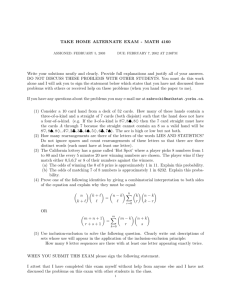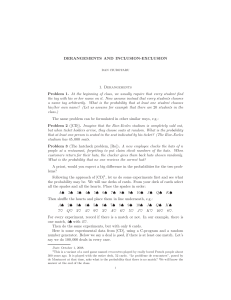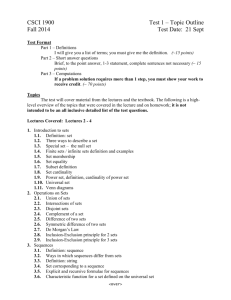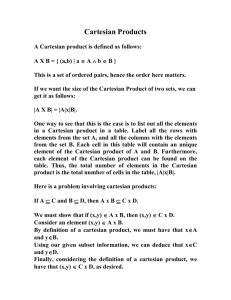THE INCLUSION-EXCLUSION PRINCIPLE Peter Trapa November 2005
advertisement
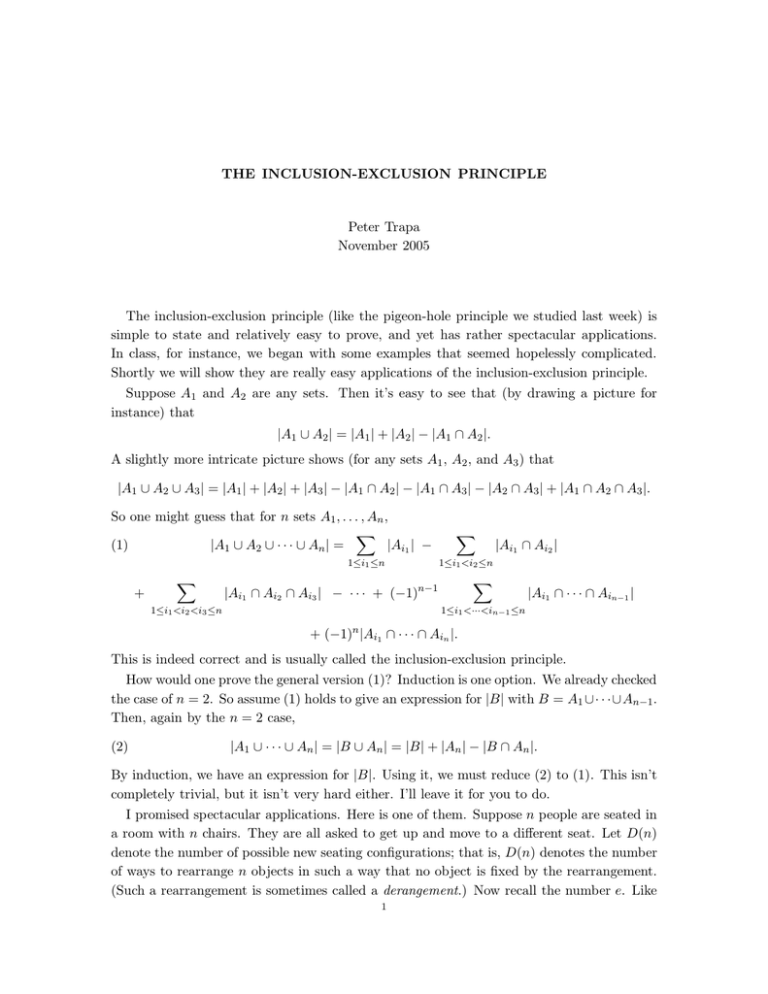
THE INCLUSION-EXCLUSION PRINCIPLE
Peter Trapa
November 2005
The inclusion-exclusion principle (like the pigeon-hole principle we studied last week) is
simple to state and relatively easy to prove, and yet has rather spectacular applications.
In class, for instance, we began with some examples that seemed hopelessly complicated.
Shortly we will show they are really easy applications of the inclusion-exclusion principle.
Suppose A1 and A2 are any sets. Then it’s easy to see that (by drawing a picture for
instance) that
|A1 ∪ A2 | = |A1 | + |A2 | − |A1 ∩ A2 |.
A slightly more intricate picture shows (for any sets A1 , A2 , and A3 ) that
|A1 ∪ A2 ∪ A3 | = |A1 | + |A2 | + |A3 | − |A1 ∩ A2 | − |A1 ∩ A3 | − |A2 ∩ A3 | + |A1 ∩ A2 ∩ A3 |.
So one might guess that for n sets A1 , . . . , An ,
X
(1)
|A1 ∪ A2 ∪ · · · ∪ An | =
|Ai1 | −
1≤i1 ≤n
+
X
1≤i1 <i2 <i3 ≤n
|Ai1 ∩ Ai2 ∩ Ai3 | − · · · + (−1)n−1
X
1≤i1 <i2 ≤n
X
|Ai1 ∩ Ai2 |
1≤i1 <···<in−1 ≤n
|Ai1 ∩ · · · ∩ Ain−1 |
+ (−1)n |Ai1 ∩ · · · ∩ Ain |.
This is indeed correct and is usually called the inclusion-exclusion principle.
How would one prove the general version (1)? Induction is one option. We already checked
the case of n = 2. So assume (1) holds to give an expression for |B| with B = A1 ∪· · ·∪An−1 .
Then, again by the n = 2 case,
(2)
|A1 ∪ · · · ∪ An | = |B ∪ An | = |B| + |An | − |B ∩ An |.
By induction, we have an expression for |B|. Using it, we must reduce (2) to (1). This isn’t
completely trivial, but it isn’t very hard either. I’ll leave it for you to do.
I promised spectacular applications. Here is one of them. Suppose n people are seated in
a room with n chairs. They are all asked to get up and move to a different seat. Let D(n)
denote the number of possible new seating configurations; that is, D(n) denotes the number
of ways to rearrange n objects in such a way that no object is fixed by the rearrangement.
(Such a rearrangement is sometimes called a derangement.) Now recall the number e. Like
1
2
THE INCLUSION-EXCLUSION PRINCIPLE
π, e is a very special number and we’ll return its definition below. It is a remarkable fact
that
(3)
1
D(n)
= .
n→∞ n!
e
lim
Some of you may know what limits are. For those of you that don’t, the expression in (3)
may informally be taken to mean “as n gets larger and larger, D(n)/n! becomes a better
and better (in fact, arbitrarily good) approximation to 1/e.”
Note why (3) is remarkable: the left-hand side involves only counting derangements,
but the right-hand side is something (as we’ll see below) that is irrational (and, in fact,
transcendental). Strange, huh?
To make sense of (3), we must understand the number e. Yes, it’s the same e that sits
on the ex button of your calculator. But how does one define ex or, in particular, e = e1 or
e−1 = 1/e? This is actually rather tricky, at least in the sense that it requires some rather
sophisticated ideas. Perhaps this is the reasons why most people who use their ex button all
the time don’t know how it is actually defined! We start with a geometric definition. Draw
a curve in the plane passing through (0, 1) so that the slope of the tangent line to any point
(x, y) on the curve is equal to y. You can quickly see that the curve must look something
like
3
slope of the tanget line
at (1.1,3) is indeeed 3.
1
1
It transpires that there is a unique such curve, and that this curve is the graph of the
function f (x) = ex . This gives one way to define ex . It is a nice intuitive definition, but it
has some problems. The main one is making precise what one means by “the tangent line to
the curve at (x, y)?” Another subtlety is that the curve so defined is actually unique. Both
issues require some understanding of calculus, so we’ll pursue another idea.
THE INCLUSION-EXCLUSION PRINCIPLE
Define
ex = 1 + x +
3
x
x
x
+ + + ··· .
2! 3! 4!
For instance,
(4)
e = e1 = 1 + 1 +
1
1
1 1
+ +
+
+ ···
2 6 24 120
and
1
1 1
1
1
= e−1 = 1 − 1 + − +
−
+ ··· .
e
2 6 24 120
The subtlety here is making sense out of what one means by an infinite sum. Some of you
may already know how to do this. If you don’t, you can informally define the above infinite
sum as follow: ex is the number so that the sequence
(5)
x
x
x2
, 1 + x + + , ...
2!
2!
3!
becomes a better and better (in fact, arbitrarily good) approximation to ex . So this definition
also requires a little sophistication.
1, 1 + x, 1 + x +
As a quick aside, once we absorb (or accept) the definition of e given in (4), it is not hard
√
to prove that e is irrational. (Remember that earlier we had proved that 2 is irrational.)
Actually it’s a little bit simpler to prove that 1e is irrational. This of course immediately
implies that e is also irrational. (Make sure you see this.) The key is that the definition
immediately implies that
1 1
1
1
− < <
2! 3! e
2!
1
1
1 1
1
1
− + < < −
2! 3! 4! e
2! 3!
1
1
1
1 1
1
1
1
− + − < < − +
2! 3! 4! 5! e
2! 3! 4!
..
.
and so on. (Again make sure that you see why this is true!) Now place the above expressions
over a common denominator. For the first few we have
3
2 1
< <
6 e
6
8
1
9
< <
24 e
24
1
45
44
< <
120 e
120
264 1
265
< <
6
e
720
..
.
and so on. The first equation implies that if 1/e were rational and written in lowest terms,
its denominator could not divide 3! = 6; the second says the denominator could not divide
4
THE INCLUSION-EXCLUSION PRINCIPLE
4! = 24; the fourth says that the denominator could not divide 5! = 120; and so on. The
conclusion is that if 1/e were rational and written in lowest terms, say with denominator N ,
then N could not divide N !. But this is absurd. So this contradiction shows that 1/e and
hence e is irrational.
Now back to (3). Since we have defined e (and 1/e) precisely, in order to establish (3)
we need to get a handle on the number D(n). Here is where inclusion-exclusion enters.
Let Ai be the number of rearrangements of n objects so that the ith object is fixed by the
rearrangement. Then it is clear that A1 ∪ A2 ∪ · · · ∪ An consists of all the rearrangements
that leave some object fixed. We are interested in the rearrangements that leave none fixed,
and since there are n! total rearrangements, we conclude that
D(n) = n! − |A1 ∪ · · · ∪ An |.
The inclusion exclusion principle is designed to compute |A1 ∩ · · · ∩ An |. In order to do so,
for any 1 ≤ i1 < · · · < ik ≤ n, we have to compute
|Ai1 ∩ Ai2 ∩ · · · ∩ Aik |.
The virtue of this approach is that |Ai1 ∪ Ai2 ∩ · · · ∪ Aik | is indeed computable! In fact
Ai1 ∩ Ai2 ∩ · · · ∩ Aik
is simply the set of permutations that fix i1 , . . . , ik , i.e. permuations of the remaining n − k
objects. So, indeed,
|Ai1 ∩ Ai2 ∩ · · · ∩ Aik | = (n − k)!.
Now we apply (1) to conclude that
|A1 ∪ · · · ∪ An | =
n
X
k=0
n
X
n
n!
(−1)
(n − k)! =
(−1)k .
k
k!
k
k=0
Then it follows that
n
X
n!
D(n) = n! − |A1 ∪ · · · ∪ An | = n! −
(−1)k
k!
k=0
1
1
1
= n! 1 − 1 + − + · · · + (−1)n
.
2! 3!
n!
And so (3) is clear.
We’ll now turn to the problems. I found many of these on the web by googling inclusion
exclusion problems. By doing so, you can find many more.
THE INCLUSION-EXCLUSION PRINCIPLE
5
exercises
1. Among 18 students in a room, 7 study mathematics, 10 study science, and 10 study
computer programming. Also, 3 study mathematics and science, 4 study mathematics and
computer programming, and 5 study science and computer programming. We know that
1 student studies all three subjects. How many of these students study none of the three
subjects?
2. Let A,B, and C be sets with the following properties:
• |A| = 100, |B| = 50, and |C| = 48.
• The number of elements that belong to exactly one of the three sets is twice the
number that belong to exactly two of the sets.
• The number of elements that belong to exactly one of the three sets is three times
the number that belong to all of the sets.
How many elements belong to all three sets?
3. Three sets A,B, and C have the following properties: |A| = 63, |B| = 91, |C| = 44,
|A ∩ B| = 25, |A ∩ C| = 23, |C ∩ B| = 21. Also, |A ∪ B ∪ C| = 139. What is |A ∩ B ∩ C|?
4. Two circles and a triangle are given in the plane. What is the largest number of points
that can belong to at least two of the three figures?
5. Fix a regular hexagon. Let S denote its vertices, together with its center. (Draw
a picture if the situation is confusion.) How many equilateral triangles have at least two
vertices in S.
6. (a) How many integers between 1 and 2005 are NOT multiples of any of the numbers
2, 3 or 5?
(b) How many integers in the set {1, 2, 3, 4, ..., 360} have at least one prime divisor in
common with 360?
(c) Find the number of integers x such that 1 ≤ x ≤ 2004 and x is relatively prime to
2005.
7. All the phone numbers in Nowheresville either start with 56, or end with 7, or both.
Otherwise, the digits of the phone number can be any of the digits 0–9. How many possible
phone numbers exist in Nowheresville?
6
THE INCLUSION-EXCLUSION PRINCIPLE
7. Let U = {1, . . . , 1000} and define subsets A2 , A3 , A5 as follows,
A2 = {n | 1 ≤ n ≤ 1000 and n is even}
A3 = {n | 1 ≤ n ≤ 1000 and n is a multiple of 3}
A5 = {n | 1 ≤ n ≤ 1000 and n is a multiple of 5}
For each Ai , write Āi for U \Ai (the complement of Ai in U ). Find the number of elements
of each of the sets listed below
(a)
(b)
(c)
(d)
(e)
(f)
(g)
(h)
A2 ∩ A3 ∩ A5
A2 ∩ A3 ∩ Ā5
A2 ∩ Ā3 ∩ A5
Ā2 ∩ A3 ∩ A5
Ā2 ∩ Ā3 ∩ A5
Ā2 ∩ A3 ∩ Ā5
A2 ∩ Ā3 ∩ Ā5
Ā2 ∩ Ā3 ∩ Ā5
8. In a math contest, three problems, A, B, and C were posed. Among the participants
there were 25 who solved at least one problem. Of all the participants who did not solve
problem A, the number who solved problem B was twice the number who solved C. The
number who solved only problem A was one more than the number who solved A and at
least one other problem. Of all participants who solved just one problem, half did not solve
problem A. How many solved just problem B?
9. How many numbers can be obtained as the product of two or more of the numbers
3,4,4,5,5,6,7,7,7?
10. How many of the first 100 positive integers are expressible as a sum of three or fewer
members of the set {1, 3, 9, 27, 81} if we are allowed to use the same power more than once.
For example, 5 can be represented, but 8 cannot.
11. How many integers can be expressed as a sum of two or more different members of
the set 0,1,2,4,8,16,31?
13. Of 28 students taking at least one subject, the number taking Math and English but
not History equals the number taking Math but not History or English. No student takes
English only or History only, and six students take Math and History but not English. The
number taking English and History but not Math is 5 times the number taking all three
subjects. If the number taking all three subjects is even and non-zero, how many are taking
English and Math but not History?
THE INCLUSION-EXCLUSION PRINCIPLE
7
13. In a survey of the chewing gum tastes of a group of baseball players, it was found
that:
22 liked juicy fruit;
25 liked spearmint;
39 like bubble gum;
9 like both spearmint and juicy fruit;
17 liked juicy fruit and bubble gum;
20 liked spearmint and bubble gum;
6 liked all three;
Given that four liked none of the above, how many baseball players were surveyed?
14. Mr. Brown raises chickens. Each can be described as thin or fat, brown or red, hen or
rooster. Four are thin brown hens, 17 are hens, 14 are thin chickens, 4 are thin hens, 11 are
thin brown chickens, 5 are brown hens, 3 are fat red roosters, 17 are thin or brown chickens.
How many chickens does Mr. Brown have?
15. Consider the following information regarding three sets A, B, and C all of which are
subsets of a set U . Suppose that |A| = 14, |B| = 10, |A ∪ B ∪ C| = 24 and |A ∩ B| = 6.
Consider the following assertions:
(1) C has at most 24 members
(2) C has at least 6 members
(3) A ∪ B has exactly 18 members
Which ones are true?
16. There are 15 students seated in classroom. The teacher is not satisfied with the seating
arrangement and demands that everyone move to a new seat. How many new configurations
are possible?
17. How many 10 digit phone numbers contain at least one of each odd digit?
18. At the annual Granite High Foxtrot-Til-You-Drop dance, 20 couples are foxtrotting
peacefully. Of the 20 couples, 10 are jock-cheerleader couples. The principal arrives and
decides that things are getting a little too steamy. He asks that everyone switch to a new
partner. Of course the jocks again end up with the cheerleaders. Given this, how many new
configurations are possible?
19. Michael has a new cell phone and he’s having difficulty remembering the new ten-digit
phone number. His memory is bizarrely fragmented: he remembers that that the second,
fourth, and fifth digits are either 7 or 9, the third and tenth digits are either a 2 or 4, there
are two zeros in the number, and the sum of the digits is 42. Given this information, how
many possibilities are there for Michael’s phone number?
